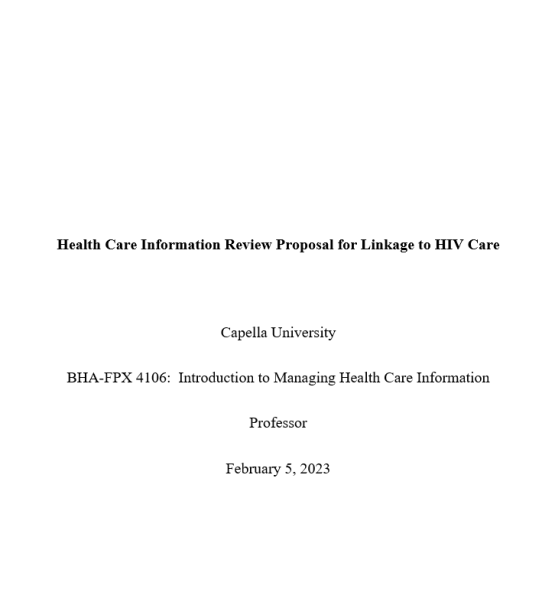


Health Care Information Review Proposal for Linkage to HIV Care
Capella University
BHA-FPX 4106: Introduction to Managing Health Care Information
Professor
February 5, 2023
Availability:In Stock
Effective data collection makes the care team responsive to the needs of patients living with HIV. The data to collect includes demographic details such as the patient’s age, progress notes, lab results, treatments, medical histories, discharge summaries, hospital admissions, and medication reviews. The information provides a comprehensive view of a patient’s condition and treatment pathways necessary to improve the quality and safety of care. The information could be used to improve the quality of care by enabling an interdisciplinary team to respond effectively to a patient’s health information, HIV test results, physician visits, and recommended treatment. This way, the care team has a broader understanding of a client’s needs and evidence-based and patient-centered interventions necessary to optimize care outcomes. It is easier to make informed decisions about quality metrics that shape clinical experiences.
The plan is to review information related to a patient’s HIV status and progress and best practices for optimizing care outcomes. The information to be collected include progress notes, lab results, treatments, medical histories, discharge summaries, hospital admissions, and medication reviews. The information are in the hospital’s electronic health records system, which makes it easier for the interprofessional care team to access and share across the facility. On the procedure for data collection, the care team will use the EHR to exchange details about the patient’s diagnosis, progress, and improvements required to produce the best results. The time period for reviewing the process is two months, which is adequate to make informed conclusions about the appropriate treatment pathways.
The computerized physician order entry (CPOE) is the system used to collect health information. The system is ideal based on the opportunity for physicians and nurses to enter patient’s information and share details about HIV medications, lab results, and radiology orders, and others through electronic means. Abouelmehdi et al. (2018) associated the system with enhanced efficiency, which facilitates flexible sending of information and a collaborative framework involving the nursing, pharmacy, laboratory, and radiology departments. This way, it is easier for the care team to monitor information flow while preventing unauthorized disclosure of sensitive details about patients’ HIV diagnosis, treatment, and progress.
The information life cycle provides the framework for accessing and sharing health information. The initial phase is identifying the systems and procedures for collection. The identified system is the Electronic Health Record (EHR), which supports a shift from paper patient records. The move enhances efficiency in collecting, processing, and storing crucial patient health information (Galetsi et al., 2019). The system facilitates easy access to demographic information, HIV test results, physician visits, and treatment. EHRs also make the care team aware of progress based on electronic notes from physician and specialist visits. Systems and procedures is among the sections from which to retrieve information about the patient’s status and patient-centered interventions implemented to optimize care outcomes. The second phase of the information flow cycle is documentation that meets standards for interoperability. The primary consideration is ensuring that systems exchange information efficiently and securely and that only authorized users access sensitive health records (Sorbie, 2020). Automated documentation enhances the ease of accessing and processing patient admission, discharge details, and other relevant details.
This proposal also accommodates the integration of health information into HIE. The process will streamline sharing of patient-level health information between doctors, nurses, pharmacists, other health care providers due to improved speed and safety of information flow. The integration will also prevent costly and redundant tests. For the fifth component of the cycle, which is storage, the electronic health record will automatically save the relevant information about patients’ HIV status and treatment pathways. Further, controlling access will involve efforts to ensure that information that goes through a doctor’s office undergoes an extensive review. Control of access will also influence retrieval of information based on the care team’s access to details about hospital stays, HIV test results, treatment, and progress reports. All information kept under the patient pseudonym with documentation containing the patient’s real name must be kept under lock and key (Abouelmehdi et al., 2018). Patient information will be protected under numerous passwords changed often and available only to those specific office members who have been trained and sworn to privacy. The last phase of the cycle is destruction, which will entail shredding, burning, pulping, or pulverizing paper records to ensure the refuse is indecipherable.
Reviews
There are no reviews yet.